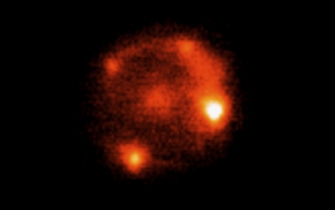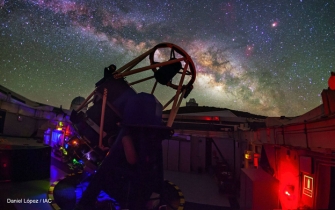
2016
21 JulyGROWTH undergraduate student makes her first discovery of a cosmic explosion in a far corner of the Andromeda Galaxy
When Kit Chinetti, a junior at Caltech majoring in Physics, found out she was going to Liverpool John Moores University in the UK for a two month summer research experience as part of the GROWTH internship program, she promptly packed her waterproof jacket and all her determination to get a good taste of what true scientific exploration is. Both proved very useful. The former is keeping her dry during her weekend trips to Scotland. The latter made her dive deep into a large pool of data from the Andromeda Galaxy (M31) in search of interesting transient objects and “Voilà!”, she discovered an cosmic explosion, known as a nova in one of the further corners of our closest galactic neighbor.
Kit had just learned how to dig into and search through the iPTF database of astronomical transient candidates from Palomar Observatory operated by Caltech. Mentored by Dr Matt Darnley and Prof. Paolo Mazzali, she was now ready to begin the detective work of identifying novae in M31. It didn’t take too long before she stumbled upon an interesting object in the data, on an otherwise, not so interesting Tuesday morning. It turned out to be a classical nova that had just erupted in one of the suburbs of the galaxy. Kit had made her first discovery!
I found a nova! iPTF16bqy is my first little contribution to transient discoveries. It's been a very exciting week.
She didn’t have much time to celebrate because she promptly had to write her first note to the Astronomer’s Telegram - an online service for posting short announcements about the detection of transient events so that the global astronomical community can use their telescopes to obtain more data for further analysis. Back in the day, astronomers were using actual telegrams to inform each other of exciting new discoveries that required prompt follow up observations.
Novae are observed when a white dwarf is locked in a binary system with a companion star with little personal space in between. As a result, the white dwarf starts eating away from the material of its partner until it fattens so much that its surface explodes and sheds away the extra mass. The explosion is powerful and for a while the resulting novae can outshine our Sun 50 000 to 100 000 times before they fade away. This may sound modest compared to supernovae which can shine as brightly as an entire galaxy, but novae have one advantage - they don’t self-destroy during the explosion and as long as they can steal material from the adjacent star they can continue to burst out every once in a while on time scales ranging from 1 to 100,000 years. Novae also fade away fast, so Kit had to quickly set up follow up observations with the 2m Liverpool telescope to obtain optical images and spectra. But why stop here? GROWTH has a large network of telescope facilities including NASA’s SWIFT telescope which can observe in gamma-ray, X-ray, ultraviolet, and optical wavebands. Kit has just gotten her request approved and she’ll soon be analyzing these data, too. Kit's mentor Dr. Matt Darnley said:
With the normal M31 observing season only really just getting started in July, we were quite fortunate to find such an interesting target so quickly into Kit’s stay in Liverpool. She can now have the exciting opportunity to follow this system from the ground with our Liverpool Telescope and from orbit with Swift for her entire internship here.
The GROWTH project provides opportunities for undergraduate students to conduct summer research projects under the guidance of a mentor from one of our international partner institutions. Kit may miss out on the Californian beach days this summer, but the beach can wait. She is busy learning how to discover the mysteries of the Universe.
Contact
Iva Kostadinova
GROWTH Communications and Media Contact
ivonata@caltech.edu
+1 626 395 2952




